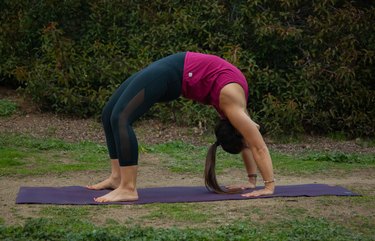
So you finally made it to a class at the hip new yoga studio in town, but rather than feeling like a peaceful warrior at the end, you felt like your body had just been through a battle. To make matters worse, the next day you woke up with an intense back ache.
If done correctly with breath, awareness and slow progressions, yoga can be beneficial for reducing back pain, increasing flexibility and building strength. The problem is that many new students come to yoga class unprepared for poses they've never done before.
Video of the Day
Video of the Day
They may have a host of mobility issues, muscle imbalances or chronic aches and pains. Back pain being the most common (approximately 8 out of 10 people will experience back pain at some point, according to the National Library of Medicine).
Here are a few common yoga poses that can potentially increase or lead to back pain when done incorrectly and what you can do to avoid pain and injury.
1. Standing Forward Fold (Uttanasana)
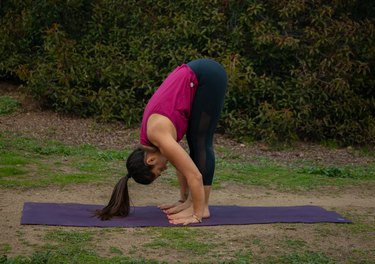
Forward folds help create space between the vertebrae and counter gravity's downward pull. But since many people lack the flexibility in their hamstrings, the lower back rounds, which lengthens the connective tissue, weakens the back and creates instability around the lumbar spine.
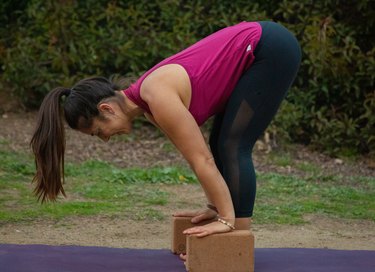
The Fix: Bend your knees. Bring the ground to you by placing your hands on blocks. Hinge at the hips maintaining length in your spine. Compress your abdomen to your thighs by engaging the abdominal muscles. Maintaining the compression, begin to straighten your legs as much as your flexibility allows.
2. Upward Facing Dog (Urdhva Mukha Svanasana)

When yoga students can't extend the thoracic spine, the lumbar spine may take the hit in backbends such as upward facing dog.
"The body will take the path of least resistance, if the thoracic spine lacks mobility the lumbar spine experiences excessive lordosis (sway in low back)," says David Lee, sports chiropractor and mobility specialist. "This causes compression and possibly degenerative changes, too."
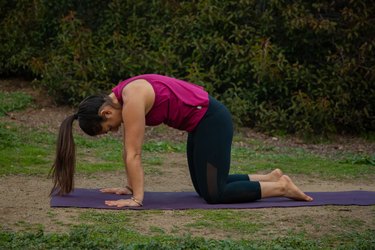
The Fix: Cat cow is a highly effective yoga pose for back pain, but to get even more out of the move, add activation with the segmental cat cow. The slow, controlled movement brings activation to each segment of the spine to improve mobility.
- Begin on your hands and knees.
- Exhale as you round your back, pull the belly button toward your spine and tuck your chin toward your chest.
- Starting at the tailbone, release one segment of your spine at a time, relaxing through the lumbar spine, thoracic spine (mid-back) and finally, your cervical spine as you lift your chin upward into full flexion.
- Then reverse the motion. Be aware of what segments feel stuck. Breathe into these spaces and remember to move slowly.
3. Four-Limb Staff Pose (Chaturanga)
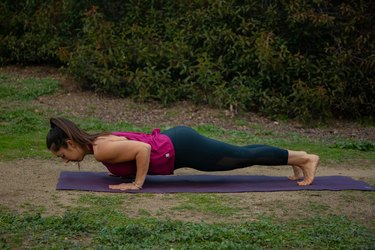
The main problem you see in chaturanga is the sway back due to lack of core strength. Without strong core engagement, the spine gets compressed. The key is to not only hug your navel to your spine, but to also activate the glutes and legs, slightly tucking the hips to lengthen the tailbone toward your heels.

The Fix: Hollow body position is an excellent core strengthener that teaches proper body alignment for chaturanga along with a host of other advanced asanas from warrior III to handstand, but it's even great for helping to improve daily movements such as standing, sitting and walking, as it improves body alignment.
- Lie on your back, lift your legs up to 90 degrees.
- Pull your navel into the spine, press your low back down into the mat.
- Roll your shoulders off the mat.
- Lower your legs to your lowest point where you can keep the low back on the mat.
- Hold.
4. Crescent Pose (Anjaneyasana)
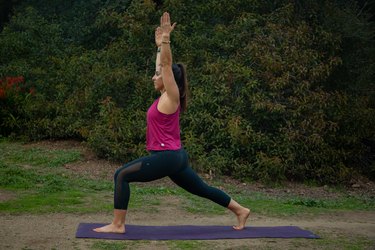
Many people compensate for lack of hip flexibility by overarching the lower back, which can cause pain over time. Instead of trying to straighten out the back leg, it's better for your lower back to keep a bend in the knee and activate the glute of the extended leg.
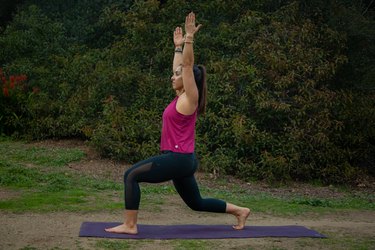
The Fix: Keep your back knee bent. Tuck the hips by rolling the frontal hip points up toward the rib cage and drawing navel to spine. Squeeze your glute to feel the stretch in your hip flexors.
5. Revolved Side Angle (Parivrtta Parsvakonasana)
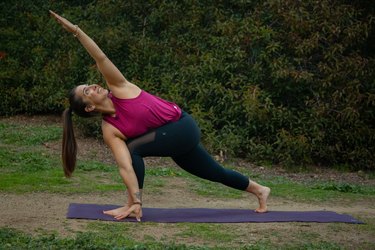
Revolved side angle pose or any twisting pose can potentially lead to low back pain if done incorrectly. This is another pose that requires thoracic spine mobility for the twist along with core engagement. The key is to try to to keep the sacrum stable so you don't over twist at the low back.
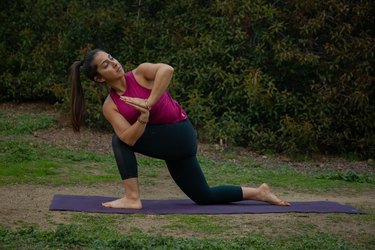
The Fix: Bring one knee to the ground to find stability. Twist and bring your hands together. On the inhale lengthen the spine and on the exhale press your hands together and press your upper arm against your upper leg to move deeper into the twist.
6. Seated Forward Fold (Paschimottanasana)
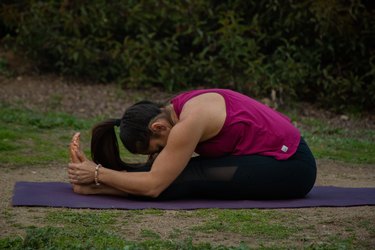
Forward folds stretch the hamstrings, but if performed improperly, forward folds may do more harm than good.
The two main problems are lower back rounding, which creates strain, and the hips hinging behind the ankles, which stresses the hamstrings and the tendons in the back of the knees, says traveling yoga teacher Joan Hyman.
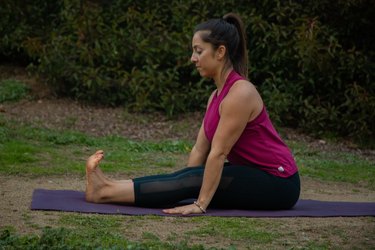
The Fix: Sit up tall with your legs together. Engage your quadriceps (tops of thighs) to lengthen your hamstrings. You can put a slight bend in the knees. Hinge at your hips while maintaining a long spine. You will feel the stretch at the top of the hamstrings rather than the low back.
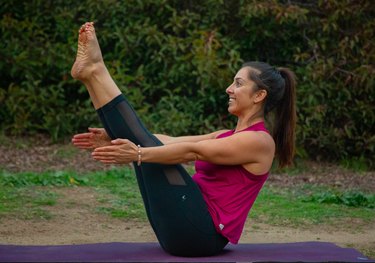
Boat pose is an excellent yoga pose to strengthen the core and create total-body strength and coordination, but the main mistake people sometimes make is rounding through the back — both upper and lower. This decreases core activation and can hurt your back if done excessively.
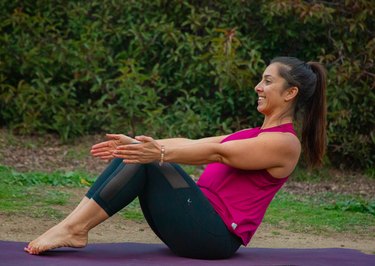
The Fix: Instead of lifting the legs, bend the knees and touch your toes down to the ground or place your feet flat on the mat. Ground down through your sit bones and lengthen the spine by drawing navel, back body and waist in toward your midline to support the spine. Think about lifting your sternum up.
8. Wheel Pose (Urdhva Dhanurasana)

Full wheel pose, urdhva dhanurasana, is a challenging pose for many, as it requires lower-body strength, spine mobility, hip flexor and quadricep flexibility, and shoulder and wrist flexibility.
This pose may compress the low back if a student lacks the above mobility prerequisites and performs this pose too fast and too early in their practice. Backbends, particularly one as full on as wheel pose, should be worked up to gradually.
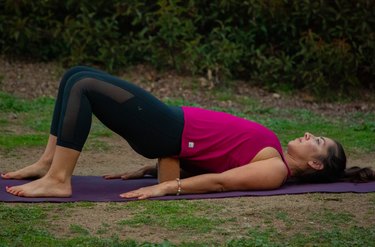
The Fix: You can still get the benefits of backbends with a more gentle version. Supported bridge is a great alternative to help create length in the lower back. Place a block under the sacrum relax on your back breathing deeply into your low abdomen and low back.
9. Plow Pose (Halasana)
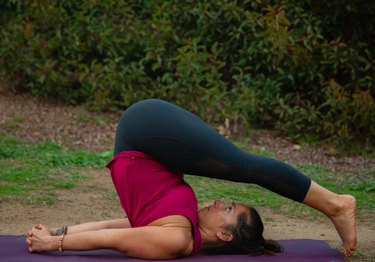
Halasana is a pose that provides a deep low back stretch. It opens the spine and shoulders and stimulates the thyroid gland. It's a deeply grounding and calming pose if performed with ease, but if not, it can be uncomfortable and injurious to the spine, particularly the cervical spine.
If a student lacks engagement of bandhas (spinal locks) to help support the spine and transfers weight to the neck versus across the shoulders, it can be problematic.

The Fix: Like supported bridge pose you can place a block under your sacrum and lift the legs up toward the sky or lie on your back facing a wall and place your legs up the wall to receive the benefits such as a stretch for the low back, restoring energy levels and improving circulation.
10. Corpse Pose (Savasana)
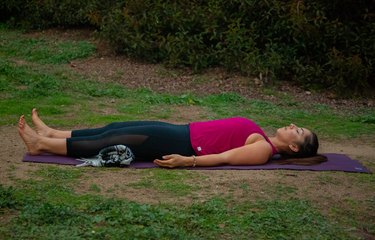
Savasana is a pose for deep relaxation. It's the final rest at the end of a yoga class to allow time for integration, but if you're not used to lying on a hard floor, it can be uncomfortable.
The Fix: Lying on your back, place a small pillow or rolled-up blanket under your head if you want. Place a bolster or rolled up blanket under your knees to protect your low back. Find length through your lower back and relax the pelvis and hips. Let your arms rest by your sides with your palms facing up.
Was this article helpful?
150 Characters Max
0/150
Thank you for sharing!
Thank you for your feedback!